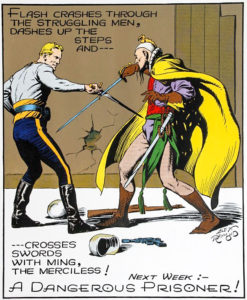 A character that is often times trotted out as a pulp character is Flash Gordon. But he’s really not, as he originated in the comic strips. Created to compete against Buck Rogers, he has outshined Buck, and would later appear in comic books, movies and serials, TV, books, radio, and even a pulp magazine. I debated doing an article on him, but feel I must, because there are pulp-like elements.
A character that is often times trotted out as a pulp character is Flash Gordon. But he’s really not, as he originated in the comic strips. Created to compete against Buck Rogers, he has outshined Buck, and would later appear in comic books, movies and serials, TV, books, radio, and even a pulp magazine. I debated doing an article on him, but feel I must, because there are pulp-like elements.
Most people recall the basic parts of the storyline, which is your “planetary romance” mixed with space opera adventure. Earth is menaced by the rogue planet Mongo. Flash and Dale Arden crash near the lab of Dr. Hans Zarkov, and the three launch into space in Zarkov’s spaceship to put a stop to it. Crashing on Mongo, they find a bizarre world of people and races, ruled over by the despotic Ming the Merciless. Flash and company team up with others, including Prince Barin and Vultan of the Hawkmen, and lead a rebellion against Ming and overthrow him. This leads to further adventures by Flash, Dale, and Zarkov on Mongo (sometimes dealing with another attempt by Ming or someone else to take over), on Earth, and on other worlds.
Initially created as a Sunday-only strip by Alex Raymond, who did it from 1934 until 1944 when he left to join the Marines. A daily strip was added in 1940 and was done by Austin Briggs. When Raymond left, the daily strip was dropped and Briggs took over the Sunday strip. Briggs would later be replaced by Mac Rayboy. A daily strip would start up again in 1951, by Dan Barry, who also took over the Sunday strip. The daily strip would finally end in 1992, and the Sunday ended in 2003. As far as I know, the dailies and Sundays ran separate storylines, similar to Buck and other adventure series.
While I’ve read a lot of Flash Gordon strips and comics, some elements are unclear. I don’t know if they were ever answered or if it was just forgotten, something I’ve seen in other comic strips were plot lines and characters are just dropped with no explanation.
Flash Gordon seems the classic hero, but also like the right person in the right place at the right time. When the strip began all we know was that he was a polo player and Yale graduate, yet he basically becomes a freedom fighter and leader of armies. Dale is more of a cypher, just happening to be a fellow passenger in the plane they are in that crashes near Zarkov’s lab. But she turns out to be a good companion and fellow fighter, but too often is a pawn in the stories, usually being pursued by Ming or some other foe, the source of jealousy for some female after Flash, or a damsel in distress (tho not to the extent Wilma is in Buck Rogers). Zarkov starts off as more of a mad scientist before becoming a stalwart companion with his scientific knowledge. In later versions, elements of these characters will be tweaked and updated, for good or bad.
Mongo in many ways is a great setting for a planetary-romance-type story, with the many kingdoms and lands populated by a variety of people and races. There are the many lands with humans (at first given an Asian look, but later to become more European in appearance) such as the forest, desert, ice, and tropics. But then you have the lionmen, hawkmen, sharkmen, and others (though it seems many of these races stopped appearing in the strip). Each land is ruled over by king, queen, or other royalty, but all ruled over by Ming from Mingo City. Ming seems the quintessential “yellow menace” villain, and most peoples’ idea of what Fu Manchu looks like is really Ming as seen in the strips or, better yet, the movie serials. He wants to kill off Flash in his arenas, take Dale for his wife, and make Zarkov create super weapons for him, all so he can rule Mongo, and probably the universe.
Now Mongo was first shown as a “rogue planet” hurtling through the solar system like When Worlds Collide. Which is strange as the various races would need to have a planet orbiting a sun to survive! But this is soon forgotten and Mongo is placed into some nearby solar system, and Flash and company travel back and forth to it all the time. Some how. Worm holes? Space warps or portals? No idea.
Of the important secondary characters are Prince Barin and Princess Aura. Barin rules the forest land of Arboria. There are hints that he is the rightful ruler of all of Mongo, and Ming is just a usurper, but I’m not sure if that is ever made clear. Barin is a strong ally of Flash, and when Ming is finally overthrown, Barin is made ruler over all Mongo in a sort of quasi-democracy. Princess Aura is Ming’s only daughter, and loves Barin. They will marry and have children.
Other characters include Prince Thun of the Lionmen, who appears in the early strips. Prince Vultan of the Hawkmen is another important character who seems to fade from the series. There is also Queen Fria of the Frigia, the Ice Kingdom.
Later strips would add further foes, both on Mongo, from other worlds (such as the insect-like Skorpi in the ’70s), and on Earth (the fascist Red Sword in the 40s, and others since). In later stories Flash becomes a kind of “roving troubleshooter” for groups like the World Space Command.
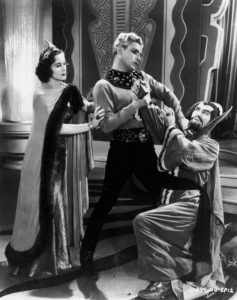
Movies & serials
For many people, if they didn’t know of Flash from the comic strips or comics, it was probably from the serials. Starring Buster Crabbe (who also stared as Buck Rogers in that serial), we got three: Flash Gordon (1936), Flash Gordon’s Trip to Mars (1938), and Flash Gordon Conquers the Universe (1940). The serials were also condensed into a set of movies. I remember watching them on TV before I read the comic strips.
But I think most people know Flash from the 1980 Dino De Laurentiis movie, with a soundtrack by Queen. (Admit it, you ran some of theme song in your head just now.) Updated, the movie turned Flash into a quarterback for the New York Jets. I thought the casting of Timothy Dalton as Prince Barin and Brian Blessed as Prince Vultan was pretty good. The outfits were based on the comic strip and the storyline condensed the first few years of the strip. While the special effects were what you expect for the time, it’s overall pretty decent, though I didn’t care for the addition of new characters like Kryton.
There has been talk of another movie, maybe animated, for awhile but nothing has happened.
TV
In the ’50s was a short-lived TV series was filmed in Germany and starring Steve Holland, the model for the Doc Savage paperback covers (and many other pulp heroes in the paperbacks) as Flash. It seems they made changes to the storyline, placing it in the far future. So no Ming or Mongo.
There have been several animated TV series with Flash, mostly aimed at kids, in the 1980s. Another in the ’90s had Flash and Dale as teenagers stuck on Mongo. Ugh.
In 2007, the SyFy channel had a live-action series that lasted one season. They modernized the characters, having Flash and company visit Mongo through a space warp created by Zarkhov, and made other changes to Ming and the people of Mongo. Ming seemed more a corporate leader-type than the original version.
Radio
There were a couple of radio serials based on Flash in the mid-1930s.
Pulp
As I noted in a prior article, there was one Flash Gordon pulp magazine issue, published by Harold Hersey, who was doing other pulps based on comic strip characters. A second issue was promised, but never appeared and may not have been written.
Books
There have been a few original books based on Flash Gordon. The best are a set of six published by Avon in the ’70s when they were also doing the original Phantom novel series.
Comic books
Over the years there have been several comic books based on Flash Gordon. The better ones include the work of Al Williamson and are based on (or inspired by) the original Alex Raymond strips. Others have either gone off in another direction, or been more modern retelling or revamping of the story.
Dark Horse Press put out five hardcover archives for the work done by five comic book companies. First was Dell, whose Flash comics were all over the place. Some had him deal with Ming, others cast him as more an American space hero going up against Commies. King Syndicate started their own King Comics and had Al Williamson do a lot of the stories, which were more in line with the classic comic. This was followed by Charlton, and later Gold Key, and then Whitman. Some of the later stuff was based on the movie.
In 1988, DC comics did a nine-issue miniseries that again updated Flash. Now a professional basketball player, he and his companions crash on Mongo, where Ming and his people are more gray-skinned than Asian. The series ended with the defeat of Ming, and left it open for further stories that never appeared. This series has never been collected in book form.
In 1995, Marvel did a two-issue series with art by Al Williamson. This work was reprinted in black and white in a book published by Flesk in 2009.
In 2008, a company named Ardden Entertainment did an updated version of Flash Gordon in a modernistic art style. Flash is an adventurous archaeology professor, Dale is some kind of CIA agent, and Zarkhov is a scientist experimenting with space portals. The whole work was collected in four trades for those interested in it. One storyline gave a history and background to Ming and Mongo.
Dynamite Entertainment has been doing the most recent Flash Gordon comic book work. They did a mini-series on Ming before Flash showed up (having his father, Krang, be emperor before him), then did a retelling of the classic Flash Gordon series under the title Zeitgeist that added in elements from the Flash Gordon movie (like Kryton) and the Filmation movie (like have Hitler work with Ming). It also turned many of the races and people of Mongo from being less human looking. Alex Ross provides the covers and some of the interior work. They’ve had further stuff with Flash under their “King: Dynamite” line, some teaming him with other King Syndicate characters.
Comic strip reprints
There have been many books over the years reprinting strips from Flash Gordon, most focusing on the classic Alex Raymond period. My main introduction to him was in the last three volumes (of 5) done by Nostalgia Press that took it up to the overthrow of Ming, but did not continue with Flash and company returning to Earth.
Kitchen Sink did a series of volumes that covered the Raymond period and part of the Austin Briggs period through 1944, when they returned to Mongo.
Kitchen Sink also did volumes reprinting half of the Austin Briggs 1940s dailies, and another volume with dailies from the 1950s.
Checker Books did a series of volumes up through the 1945 Sunday strips.
Dark Horse Comics did a series of volumes of the Mac Rayboy Sundays from 1948-67.
Tempo Books did six massmarket paperback books collecting Sundays (in black and white) and dailies from the 1970s.
Most recently, IDW has done four large volumes of the Alex Raymond Flash that includes the Jungle Jim “topper” strip (also done by Raymond). And Titan Books is doing a series of Flash Gordon volumes under the “Complete Flash Gordon Library” that includes both Sundays and dailies that has now progressed to the 1950s work of Dan Barry.
So a lot of opportunity to read and enjoy Flash Gordon, especially with the current Titan series. If you just know Flash from one media (like the movie), check out the others, especially the classic comic strips. For me, the better comics are the ones done by Al Williamson, or which try to adhere to what Raymond did, as opposed to creating a sort of modernized recasting.
“Flash! He’ll save every one of us!”

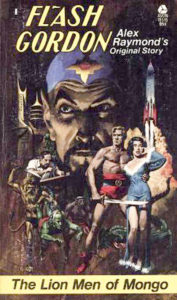
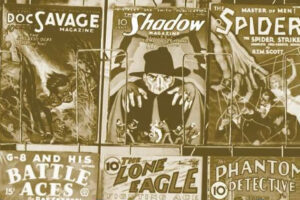

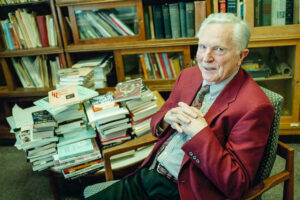
Nice revisit of this classic.
I was introduced to Buck Rogers in my youth via a gigantic collection my grandfather had on his shelf; a book of newspaper reprints in color and black and white.
Then the Flash and Buck serials which played on our local public Tv station.
Hooked and still hooked.
I used over-analyze why these stories and serials brought me a sense of comfort. It really boils down to the joy of discovering them as a kid in the comfort of my grandfather’s chair where I was also introduced to the Shadow, Tarzan, Sherlock, Hitchcock and dozens of classic old-time radio shows.
I can still smell my grandfather’s pipe when I’m buried in one of these old books.
Thanks, as always, for you enjoyable posts!
I was also introduced to Buck thru that same collection: the big 2in thick one from Chelsea House at my aunt’s house. See my posting on Buck for more on this.
My review of the classic 1936 serial:
https://derricklferguson.wordpress.com/2011/06/26/flash-gordon-1936/